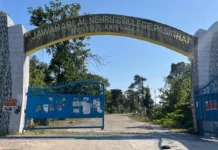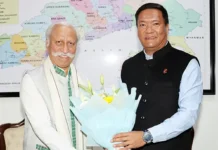[ Nani Bath ]
Arunachal Pradesh, as its stands today, is a product of diverse factors – as diverse as the state itself. Historically, it was neither a part of British India nor was it under the Tibetan administration. The tribal communities lived a life of their own, occasionally indulging in inter-clan feuds over land, forest and women. The British India considered the area as an extension of the great Tibetan plateau that remained as a buffer zone to thwart Chinese influence in the eastern frontier of Bengal.
After India’s independence, Jawaharlal Nehru, the architect of modern India, desired that the ‘destiny’ of the people of the North East Frontier Agency (NEFA) needed to be guided, so that they would be allowed to “develop in the lines of their own genius.” It was because of its strategic location and the geopolitical significance of the area vis-à-vis China.
Secondly, Nehru was concerned about the potential influence of the Naga separatist movement and the Christian missionaries in the Naga and Mizo hills. The policy envisaged by Nehru, often called the Nehru-Elwin ‘Non-interference’ policy, was given a second look after the 1962 aggression of China on India. Post 1962, modern governmental institutions were sought to be introduced, so that the territory could come closer to the mainstream of the political life in the country. The first step towards realizing these objectives was to appoint a four-member committee, popularly known as D Ering Committee.
In making its recommendations, the committee was asked to take into consideration the scope and pattern of authority and functions exercised by the indigenous tribal institutions. It was to examine how far the existing indigenous system was adequate, and how best it could be modified or enlarged to introduce democratic working in the fields of judiciary, local development and administration.
The Ering Committee submitted its 93-page report in January 1965 with certain politically and administratively significant recommendations. The Ering Committee never used the term panchayati raj or democratic decentralization but “it was clearly intended to be the system in Arunachal Pradesh.” It recommended that, as practical as possible, non-external and indigenous system should be retained, and that the election to the councils should be conducted according to the tribal customs.
The president of India promulgated the North East Frontier Agency Panchayati Raj Regulation, 1967, framed on the basis of the Daying Ering Committee recommendations. However, the regulation was not to be implemented in seppa subdivision, and Miao-Vijayanagar areas of Tirap district because of their remoteness and backwardness.
The first elections to the panchayati raj institution were held in 1969 to constitute five zilla parishads and 39 anchal samitis.
To conform to the provisions of the 73rd Constitution Amendment Act, the Arunachal Pradesh Panchayati Raj Ordinance, 1994, was passed. The 1994 ordinance was reserved by the governor for the assent of the president of India. The same ordinance was returned to the state government with the following suggestions: constitution of gram sabhas; reservation of seats for scheduled caste members; and direct elections to the panchayat bodies.
The Arunachal Pradesh Panchayati Raj Bill, 1997, was passed by the state legislative assembly, replacing the ordinance, and was sent to the government of India for the president’s assent. It incorporated the suggestions made by the president, except that it did not include provision for reservation of seats for the scheduled caste. The GoAP maintained that Arunachal Pradesh is a hundred percent tribal state and no indigenous scheduled caste population inhabits the state.
The president reserved the bill on the issue of reservation of seats to scheduled caste. Meanwhile, the government of India introduced the Constitution (86th Amendment Bill, 1999) in the parliament, seeking exemption of the state from the requirement of reservation for the scheduled caste. The bill was passed by the parliament in 2000, and it became the 83rd Constitution Amendment Act. The Arunachal Pradesh Panchayati Raj Act, 1997, was formally notified on 30 April, 2001.
Post-1962 again, it was realized by the strategic thinkers and the political leadership that the territory of the NEFA being vast and sparsely populated, there was a need of resettlement of people in the vacant border which would help strengthen our frontiers and their defence. It was also felt that the settlement of outsiders in the NEFA would help in developing the pockets which were lying unused and unoccupied by the local population.
From a strategic point of view, the administration presumed that “the presence of stretches of vacant land along the border is strategically not desirable and the last emergency had highlighted this problem.”
Around 14,888 (2,748 families) Chakmas and Hajongs were settled in the then three districts of NEFA – Lohit, Tirap and Subansiri – during 1964-69. At present, there are 44,276 Chakmas in Changlang district, 4,962 in Namsai district and 2,077 Chakmas in Papum Pare district. The Hajongs are concentrated only in Diyun subdivision of Changlang district, numbering 2,415 persons.
In the line of this strategic thinking, 200 families of ex-Assam Rifles were settled in the “virgin unoccupied, un-administered and remote border area (Vijaynagar) under planned scheme of India” from 1967-71. According to the ministry of home affairs, the objectives and considerations of the scheme were:
(i) The NEFA as a whole was comparatively thinly populated; (ii) A population vacuum near the border might result in attempts by hostile neighbour to take advantage of the situation; (iii) A settled community along the border would be a positive deterrent against the temptation of infiltration from across the border; (iv) The actual presence of a settled community along the border would further reduce the scope of any border dispute; (v) A progressive community would boost the morale of the local inhabitants and inspire greater zeal for accelerated economic progress; and (vi) The settlement of people belonging to mixed communities in the NEFA might help towards emotional integration of the NEFA people with the rest of the country.
On the similar pattern of the model scheme approved for settlement of ex-Assam Rifles families in Vijaynagar, 190 families of ex-servicemen were resettled near Seijosa in Kameng district of the North East Frontier Agency. The government of India in January 1969 sanctioned resettlement of 75 families in that place at a cost of Rs 24.23 lakhs. In September, 1970, resettlement of 115 families more at a cost of Rs 28.83 lakhs was sanctioned. However, the settlers deserted the area because of unsuitability of land for cultivation and other geographical factors.
The government of India perhaps did not anticipate the nature of clashes and contestations among the communities. There seems to be a simmering discontentment between the Yobins and the ex-Assam Rifles families on the one hand. On the other, the indigenous communities, represented by the All Arunachal Pradesh Students’ Union (AAPSU), have objected to the settlement of the outsiders and granting of APST status to the Yobins. The same position remains as of today.
The Yobins and the ex-Assam Rifles families are competing for space, both political and geographical.
The Yobins have been suffering immensely ever since they were ‘spotted’ by the Indian military in 1961. Their scheduled tribe status remains in suspended animation because of some technical issues. They are deprived of basic amenities – lack of road communication, inadequate supply of essential items, etc. The Miao-Vijaynagar road remains in a state of limbo since the early sixties. The end result is the manifestation of frustration in the form of arson and violence.
The ex-Assam Rifles families, consisting mostly of Gorkhas, feel physically threatened and have sought protection from all quarters, including Home Minister Rajnath Singh. They even indicated that the intervention of the Supreme Court would be sought. In 1989, a writ petition was filed in the Supreme Court by the Assam Rifles Multipurpose Cooperative Society, praying for directions to the respondents for implementing the scheme approved by the government of India for settling retired defence personnel. The court ruled that “It is in the public interest and for the benefit of the public that settlement of Indian citizens should be encouraged in this area and the area should be suitably developed.”
One of the primary demands of the All Yobin Students’ Union is that the retired Assam Rifles settlers should have no right to contest the panchayat polls, as they are non-APST. The AAPSU’s demand is for exclusion of all non-APSTs from the right to contest panchayat elections. It is demanding that the state government make necessary amendments in the Panchayati Raj Act to this effect.
An analysis of the provisions of the PR 1997 Act gives us to understand that no clause of the act debars any non-APST from the contest. There is no reservation provision for the communities belonging to the APST either. The criteria provided to be a member of the gram panchayat and the zilla parishad are that, one has to be a citizen of India; 21 years of age; does not hold any office of profit; has not been dismissed from government services; not of unsound mind. And one who has attained the age of 18 years and is an ordinary resident of the area could be registered as electors. One who owns and is in possession of a dwelling house is considered an ordinary resident.
The recent incidence of arson in Vijaynagar is an indication of some tumultuous days ahead for the state of Arunachal Pradesh. The governments need to address the apprehensions of the indigenous communities and the concerns of the ‘outsiders’, who are already settled in the state – Chakmas, Hajongs, retired Assam Rifles personnel, Yobins, Mishings, Karbis, Bhutias, etc.
The possibilities are that the foreign/enemy elements (China) may take advantage of the prevailing situation. Since the Indian Army is well poised to counter all misadventures of the Chinese PLA, China may try its luck to do a mischief from Burmese land.
What we need today is a comprehensive state policy vis-à-vis the ‘outsiders’. The time has come for us to realize the fact that a solution has to be found, the sooner the better. The government needs to invite all stakeholders, consult experts, and go for a final solution. The institution of panchayati raj, which has brought uniform political structure across the communities, cannot be allowed to be seen as a divisive force. Hopefully, the issue is not messed up again. (The author is Professor of Political Science, Rajiv Gandhi University, Rono Hills. He can be contacted at nanibath@rediffmail.com)





